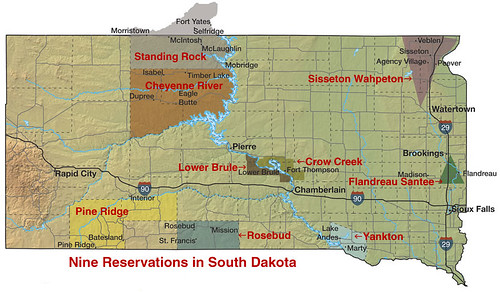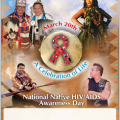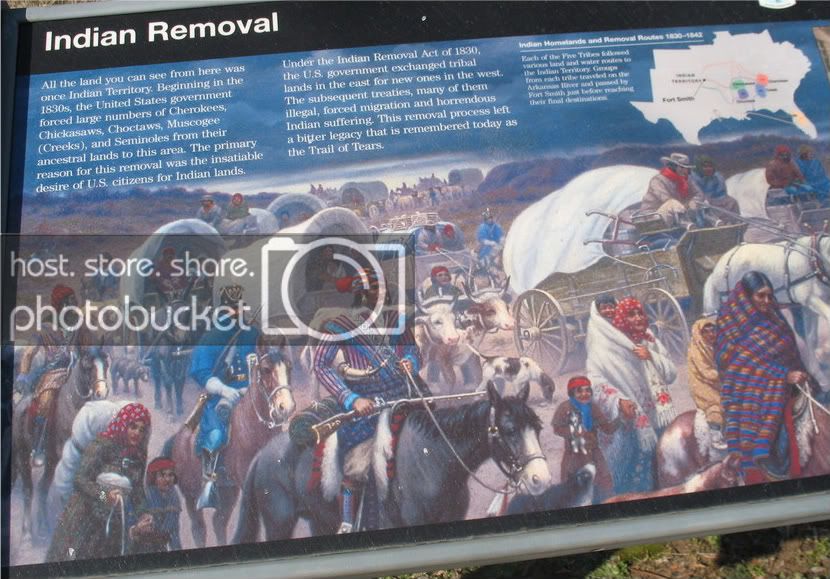Thanks to navajo and a robust crew of volunteers and diarists, the snow emergency on the Indian Reservations in the Dakotas found its way to the TV (thanks, Keith!) and more donations have started to flow. (Navajo’s excellent compilation of donation contact info and links here.) My intention is to add a little background to the story, because it’s annoying as all get-out that this has ever become a situation for charity.
In the early days of the United States, Indian Affairs was an agency under the War (later Defense) Department. Not unlike the private contractors in Iraq, the Indian agents in the field typically did much better than the people they were charged with protecting and assisting. Often much better.
With much bloodshed and ruthless, duplicitous behavior, the indigenous population of the US was driven from its homelands, and confined to reservations. (Except for the tribes, like the Mandans on the Plains, that died off completely.) Tactics included wanton slaughter of the buffalo to deprive the natives of their means of material survival, thus forcing them into submission and opening up their territories for white settlers. Public debate back in the 1800s centered on questions like whether or not the Indians were human possessing souls, and whether the nations first peoples should be “civilized” or simply killed off by genocide.
Private Allotments
The latter option was only partially accomplished (via bounties for Indian scalps, and other atrocities), and the former eventually became policy. In the 1880s, the Dawes Act was passed, dividing much reservation land into individually owned allotments, meant to be developed as family farms. In short order, most Indian land ended up in non-Indian ownership. This is not so surprising, if one considers that the Indians had non-written languages, and concepts like foreclosure and executed contracts and arguing cases before judges in courtrooms were utterly and completely alien to them. The very concept of individuals owning a piece of ground wasn’t how they’d ever thought about their relationship to Mother Earth. Of course, this is grossly oversimplified, since there are a wide array of cultures amongst the hundreds of different tribes once native within the present U.S. boundaries. But it applies pretty well to the nomadic Plains tribes with reservations on the High Plains.
In time, the ability to transfer title of Indian land to non-Indian owners was curtailed. (Except when the Congress declares an emergency – like in World War II, when large tracts of Lakota and Washington state’s Nisqually lands got annexed to military facilities, never to be returned. But I digress.)
Legally, to this day, the federal government has a trust responsibility towards the tribes. Tribes exist, legally, as dependent sovereign entities, with all the ambiguity and confusion that oxymoronic phrase suggests. There are treaty obligations the U.S. government owes the tribes, in exchange for giving up most of the country. For laying down their arms, and not contesting (i.e. killing) settlers taking over most all of what was once theirs. Those obligations include health care, education and various general welfare items such as roads.
Too often, uninformed people tend to think of those obligations as some kind of welfare. I think of it is as if there were an “interest-only” mortgage on the entire country, and the U.S. owes, in perpetuity, to make good on the deal.
The Cobell Case
There’s another frequently overlooked angle on the impoverished state of the reservations. The federal government, via the Bureau of Indian affairs (long since transferred from War to Interior Dept.), acts as a trustee for both the tribes and the owners of the individual land allotments. Remembering that the allotments were first carved up back in the 1800s, and that the owners typically died without written wills or even file change of title (much less have a survey done) when a piece of land was sold or given away, keeping track of the ownership of these tracts is a non-trivial problem.
The feds, as trustees, have leased out lands for various purposes over the decades – purposes such as logging, mining, grazing, farming (where non-Indians could get soil bank payments for not planting crops, but Indians could not) and oil and gas drilling. As trustees, the Bureau of Indian Affairs (BIA) was supposed to account for those payments, and disburse them to the land owners.
The records were bad, and back in the 1990s, a Blackfeet woman from Montana called Eloise Cobell, a banker, started getting serious about getting those records accounted for, and proper payments made to landowners for said leases. Let me restate the problem: For well over a century, the US government had been taking in lease payments, but couldn’t account for something in excess of $100 billion dollars dating back to the 1880s. A trustee in any other context would have had their ass tossed in jail long since for such sloppy work. To be clear, payments were made over, but there weren’t records to account for it all.
And so was born the Cobell class action lawsuit, filed in 1996:
On June 10, 1996, Indian plaintiffs including Elouise P. Cobell, Mildred Cleghorn, Thomas Maulson and James Louis Larose, filed a class action lawsuit against the federal government for its failure to properly manage Indian trust assets on behalf of all present and past individual Indian trust beneficiaries, including over 300,000 current Individual Indian Money (IIM) account holders. The assets at issue are the monies that belong to the individual Indians. The named defendants are the Secretaries of the Interior and Treasury and the Assistant Secretary-Indian Affairs
The case moved along slowly under a Reagan-appointed federal judge, until the Bush-Cheney years. Gale Norton and her minions got declared in contempt of court by Judge Lambeth, who had strong language about their lack of good faith action in the matter. So strong that the Bush Justice Department successfully moved to have him removed, nearly a decade into the case. John McCain, Chairman of the Indian Affairs Committee while the Republicans were in the majority in the Senate insisted that $25 million was too large a sum to settle on the case. So it went nowhere.
On June 10, 1996, Indian plaintiffs including Elouise P. Cobell, Mildred Cleghorn, Thomas Maulson and James Louis Larose, filed a class action lawsuit against the federal government for its failure to properly manage Indian trust assets on behalf of all present and past individual Indian trust beneficiaries, including over 300,000 current Individual Indian Money (IIM) account holders. The assets at issue are the monies that belong to the individual Indians. The named defendants are the Secretaries of the Interior and Treasury and the Assistant Secretary-Indian Affairs.
…
also in 2008, the District Court granted equitable restitution to the plaintiff class based on the unproven shortfall of the trust’s actual value as compared with its statistically likely value. It stressed that breaching the duty to account did not generate the government’s financial liability. Rather, it said the government’s failure properly to allocate and pay trust funds to beneficiaries gave rise to restitution or disgorgement of the very money that had been withheld. The plaintiff class was awarded $455,600,000 (although this figure did not include interest).
A settlement was announced two months ago on December 8, 2009 – a specific case where the Democrats are different from (and better than) the Republicans:
Yes. The federal government has agreed to create a $1.412 billion Accounting/Trust Administration Fund and $2 billion Trust Land Consolidation Fund. The Settlement also creates a federal Indian Education Scholarship fund of up to $60 million to improve access to higher education for Indian youth.
Needless to say, it’s too soon for this all to have been implemented, but it’s a step in the right direction. And, too, remember that none of this is welfare or charity. It’s what’s due – long past due.
The Current Situation
What I’ve written above isn’t immediately germane to the acute crisis currently unfolding on the reservations. That’s the consequence of other kinds of neglect and malfeasance than just that covered in the Cobell suit, which litigation only covers accounting for leases of individually-owned land allotments.
Basic welfare issues on the Reservations are the responsibility of the federal government. State jurisdiction is limited, and rightly so, owing to disputes like those of salmon fishing rights of Coast Salish tribes in western Washington. As it happens, I was in the courtroom when the 1974 Boldt decision was delivered, and the wiki description comports with my own understanding of the case:
The decision was the culmination of years of State of Washington limitation of treaty fishing by the Tribes, resulting in the United States suing the State of Washington to force the state to comply with the treaties. It was immediately met with shock and outrage by non-Native fishermen, but the ruling has held for more than 30 years.
The Boldt decision also upheld that U.S. federal treaties signed with the Native Americans continue to be in effect as are all International Treaties agreed to with the U.S. government.
So, the donations are good, as a humanitarian effort to rescue people in trouble in an emergency situation. Navajo’s diary from yesterday is full of contact information and links for donations, such as:
Thanks to Kossack Keith Olbermann, 3 major charities benefiting the South Dakota reservations will get some huge donations now. Today, I want to call your attention to a faster and more direct way you can help. The LIHEAP (Low Income Home Energy Home Assistance) programs ran out of winter funding in early December. Here’s the hard part; you will need to write a check because of no online presence for any tribe.
But Keith got it right in the bolded words below:
Transcript courtesy of Kimberley:
“And now tonight’s first Quick Comment, and you overwhelm me–as usual.
“Last night, continuing our coverage of the humanitarian crisis on the ice storm and blizzard ravaged reservations of South Dakota, I mentioned a Cheyenne River Sioux Tribe Storm Relief emergency assistance fund, and we linked to it. They were hoping, by the end of the month, to have raised $35,000.
In 24 hours, you donated approximately $185,000. They thank you and I thank you.
“If anybody wants to go further, the chairman of the tribe tells us the consciousness of politicians is as important as donations right now. FEMA has yet to declare the region a disaster area, and there’s something else that could kill about 40 birds with one stone there: They’ve patched much of the water and power infrastructure back together but they really need an overhaul and something in the jobs bill, or some stimulus money, could not only protect power, heat and water there, it could also put some of the thousands of unemployed Native Americans to work in their own communities. So you could call, write, or e-mail your congressmen and or senator.
So this diary is a call for action that way – putting a little pressure on the political will. Reminding our elected officials that the nation has a trust obligation to the tribes. It’s not charity, and it’s not welfare, and there’s a lot of room for improvement. Contacting any Senator or House member could help, but those serving on the Senate Indian Affairs Committee are particularly relevant, so here’s their contact information. You know what to do from here:
Senate Indian Affairs Committee
Democrats:
Daniel Akaka (Hawaii) 202-224-6361
Maria Cantwell (Washington) 202-224-3441
Kent Conrad (North Dakota) 202-224-2043
Bryon Dorgan, chair (South Dakota) 202-224-2551
Al Franken (Minnesota) 202-224-5641
Daniel Inouye (Hawaii) 202-224-3934
Tim Johnson (South Dakota) 202-224-5842
Jon Tester, (Montana) 202-224-2644
Tom Udall (New Mexico) 202-224-6621
Republicans:
John Barrasso, Vice Chairman (Wyoming) 202-224-6441
Tom Coburn (Oklahoma) 202-224-5754
Michael Crapo (Idaho) 202-224-6142
Mike Johanns (Nebraska) 202-224-4224
John McCain (Arizona) 202-224-2235
Lisa Murkowski (Alaska) 202-224-6665
BACKGROUND
There are nine reservations In South Dakota. News reports are covering only two reservations, Pine Ridge and Cheyenne River.
courtesy of South Dakota Office of Tribal Government Relations
We’ve also had a number of Kossacks volunteer to be a part of a new team (currently un-named) that will focus on a continuing diary series on the current conditions of our poorest reservations and discuss proactive and preventative measures that could be taken to prevent similar disasters next winter.
Daily Kos volunteers for this effort currently are:
4Freedom, Aji, bablhous, Bill in MD, cacamp, Deep Harm, exmearden, KentuckyKat, Kimberley, Kitsap River, Land of Enchantment, Lexalou, No Way Lack of Brain, oke, ParkRanger, Richard Cranium, SarahLee, Soothsayer, swampus, TiaRachel, tlemon, translatorpro, Zenox
Many thanks to them for all their research and support.




but if money is in trust for the tribes aren’t natives in charge of that money or is it distributed by the US gov’t, monthly,quarterly,yearly? If so why aren’t the tribes in charge of it?
I’m glad Cobell was finally settled, for a pittance I might add. Could this create a precedence for future law suits?
Tuesday, March 9, 2010
I’ve been waiting for this – President Barack Obama has issued the disaster declaration for South Dakota’s blizzards.
This will finally allow FEMA funds to be made available for repairs. I hope we can hear that this happens in the neatr future.
I hear there is another large storm heading towards western SD now. Hope everyone there is safe and spring comes soon.